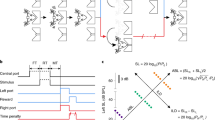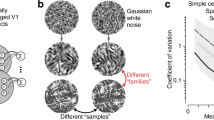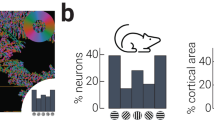Abstract
Perceptual discrimination improves with practice. This ‘perceptual learning’ is often specific to the stimuli presented during training1,2,3,4,5, indicating that practice may alter the response characteristics of cortical sensory neurons6,7. Although much is known about how learning modifies cortical circuits8, it remains unclear how these changes relate to behaviour. Different theories assume that practice improves discrimination by enhancing the signal1,9,10, diminishing internal noise11,12 or both13. Here, to distinguish among these alternatives, we fashioned sets of faces and textures whose signal strength could be varied, and we trained observers to identify these patterns embedded in noise. Performance increased by up to 400% across several sessions over several days. Comparisons of human performance to that of an ideal discriminator showed that learning increased the efficiency with which observers encoded task-relevant information. Observer response consistency, measured by a double-pass technique in which identical stimuli are shown twice in each experimental session14,15, did not change during training, showing that learning had no effect on internal noise. These results indicate that perceptual learning may enhance signal strength, and provide important constraints for theories of learning.
This is a preview of subscription content, access via your institution
Access options
Subscribe to this journal
Receive 51 print issues and online access
$199.00 per year
only $3.90 per issue
Buy this article
- Purchase on Springer Link
- Instant access to full article PDF
Prices may be subject to local taxes which are calculated during checkout




Similar content being viewed by others
References
Poggio,T., Fahle,M. & Edelman,S. Fast perceptual learning in visual hyperacuity. Science 256, 1018–1021 (1992).
Fiorentini,A. & Berardi,N. Perceptual learning specific for orientation and spatial frequency. Nature 287, 43–4 (1980).
Fahle,M. & Morgan,M. No transfer of perceptual learning between similar stimuli in the same retinal position. Curr. Biol. 6, 292–297 (1996).
Ball,K. & Sekuler,R. Direction-specific improvement in motion discrimination. Vis. Res. 27, 953–965 (1987).
Sagi,D. & Tanne,D. Perceptual learning: learning to see. Curr. Opin. Neurobiol. 4, 195–199 (1994).
Karni,A. & Sagi,D. Where practice makes perfect in texture discrimination: evidence for primary visual cortex plasticity. Proc. Natl Acad. Sci. USA 88, 4966–4970 (1991).
Vogels,R. & Orban,G. A. The effect of practice on the oblique effect in line orientation judgments. Vis. Res. 25, 1679–1687 (1985).
Buonomano,D. & Merzenich,M. Cortical placticity: From synapses to maps. Annu. Rev. Neurosci. 21, 149–186 (1998).
Mackintosh,N. Conditioning and Associative Learning (Oxford Univ. Press, New York, 1983).
Weiss,Y., Edelman,S. & Fahle,M. Models of perceptual learning in vernier hyperacuity. Neural Comp. 5, 695–718 (1993).
McLaren,I., Kaye,H. & Mackintosh,N. in Parallel Distributed Processing: Implications for Psychology and Neurobiology (ed. Morris, R.) 102–130 (Clarendon, Oxford, 1988).
McLaren,I. in Causal Mechanisms of Behavioural Development (eds Hogan, J. & Bolhuis, J.) 377–402 (Cambridge Univ. Press, Cambridge, 1994).
Dosher,B. A. & Lu,Z. Perceptual learning reflects external noise filtering and internal noise reduction through channel reweighting. Proc. Natl Acad. Sci. USA 95, 13988–13993 (1998).
Green,D. M. Consistency of auditory detection judgments. Psychol. Rev. 71, 392–407 (1964).
Burgess,A. E. & Colborne,B. Visual signal detection. IV. Observer inconsistency. J. Opt. Soc. Am. A 5, 617–627 (1988).
Tjan,B. S., Braje,W. L., Legge,G. E. & Kersten,D. Human efficiency for recognizing 3-D objects in luminance noise. Vis. Res. 35, 3053–3069 (1995).
Legge,G., Kersten,D. & Burgess,A. E. Contrast discrimination in noise. J. Opt. Soc. Am. A 4, 391–406 (1987).
Pelli,D. G. in Vision: Coding and Efficiency (ed. Blakemore, C.) 3–24 (Cambridge Univ. Press, Cambridge, Massachusetts, 1990).
Burgess,A. E., Wagner,R. F., Jennings,R. J. & Barlow,H. B. Efficiency of human visual signal discrimination. Science 214, 93–94 (1981).
Desimone,R. Face-selective cells in the temporal cortex of monkeys. J. Cog. Neurosci. 3, 1–8 (1991).
Yin,R. K. Looking at upside-down faces. J. Exp. Psychol. 81, 141–145 (1969).
Tolhurst,D. J., Movshon,J. A. & Dean,A. F. The statistical reliability of signals in single neurons in cat and monkey cortex. Vis. Res. 23, 775–785 (1983).
van Meeteren,A. & Barlow,H. B. The statistical efficiency for detecting sinusoidal modulation of average dot density in random figures. Vis. Res. 21, 765–777 (1981).
Zohary,E., Celebrini,S., Britten,K. H. & Newsome,W. T. Neuronal plasticity that underlies improvement in perceptual performance. Science 263, 1289–1292 (1994).
Logothetis,N. K., Pauls,J. & Poggio,T. Shape representation in the inferior temporal cortex of monkeys. Curr. Biol. 5, 552–563 (1995).
Pascual-Leone,A. & Torres,F. Plasticity of the sensorimotor cortex representation of the reading finger in Braille readers. Brain 116, 39–52 (1993).
Recanzone,G. H., Schreiner,C. E. & Merzenich,M. M. Plasticity in the frequency representation of primary auditory cortex following discrimination training in adult owl monkeys. J. Neurosci. 13, 87–103 (1993).
Schiltz,C. et al. Neuronal mechanisms of perceptual learning: changes in human brain activity with training in orientation discrimination. Neuroimage 9, 46–62 (1999).
McIntosh,A. R., Rajah,M. N. & Lobaugh,N. J. Interactions of prefrontal cortex in relation to awareness in sensory learning. Science 284, 1531–1533 (1999).
Gold,J., Bennett,P. J. & Sekuler,A. B. Identification of band-pass filtered letters and faces by human and ideal observers. Vis. Res. 39, 3537–3560 (1999).
Acknowledgements
This research was funded by grants to P.J.B. and A.B.S. from the Natural Science and Engineering Research Council of Canada. We thank R. Sekuler for comments and suggestions.
Author information
Authors and Affiliations
Corresponding author
Rights and permissions
About this article
Cite this article
Gold, J., Bennett, P. & Sekuler, A. Signal but not noise changes with perceptual learning. Nature 402, 176–178 (1999). https://doi.org/10.1038/46027
Received:
Accepted:
Issue Date:
DOI: https://doi.org/10.1038/46027
This article is cited by
-
Improved modeling of human vision by incorporating robustness to blur in convolutional neural networks
Nature Communications (2024)
-
Knowledge generalization and the costs of multitasking
Nature Reviews Neuroscience (2023)
-
Effects of task-specific strategy on attentional control game training: preliminary data from healthy adults
Current Psychology (2023)
-
Efficient neural codes naturally emerge through gradient descent learning
Nature Communications (2022)
-
Current directions in visual perceptual learning
Nature Reviews Psychology (2022)
Comments
By submitting a comment you agree to abide by our Terms and Community Guidelines. If you find something abusive or that does not comply with our terms or guidelines please flag it as inappropriate.



